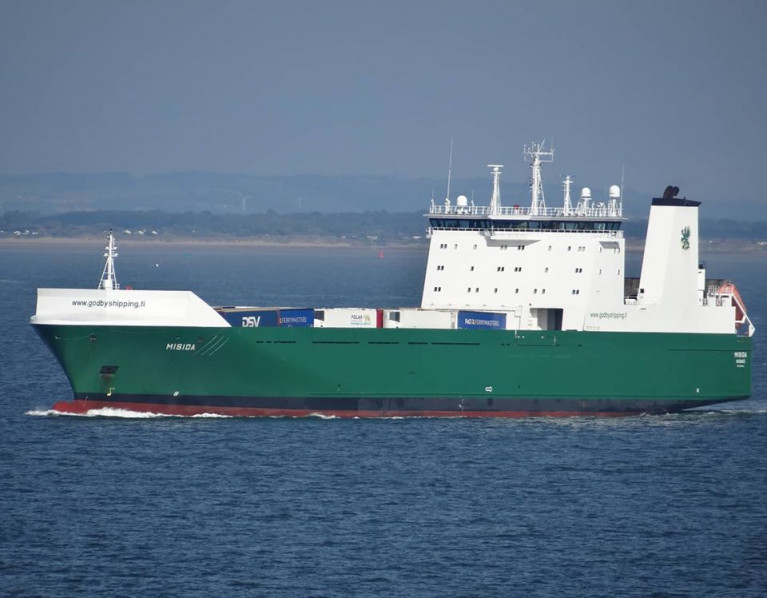Displaying items by tag: Fourth (Finnish) Freighter
Finnish Island Based Operator's Ro-Ro Freight-Ferry Feeds into P&O's Dublin-Liverpool Service
A Finnish island based shipping operator has a ro-ro freighter on charter to P&O Ferries Dublin-Liverpool on the intensive central Irish Sea corridor link which currently only has one passenger ferry in service, writes Jehan Ashmore
Godby Shipping AB of Mariehamn, the capital of Åland Islands located in Baltic Sea between Finland and Sweden, has its ro-ro freight only Misida time-chartered to P&O. Misida brings a boost in capacity for 150 trailers (2,155 freight lane meters) throughout the decks of the 2007 built 14,100 gross tonnage ship.
Misida last month became the fourth ship to boost capacity having joined P&O's ropax sister's Norbank and Norbay in addition to another charter of Clipper Pennant from Seatruck Ferries. However, currently the service is reduced to three ships as Afloat reported the 125 freight-trailer / 114 passenger ropax Norbay is offservice from the Liffey-Merseyside link due to dry-docking on the opposite side of the England at the facility of A&P Tyne, near Newcastle on the North Sea.
In the meantime Misida operates Norbay's roster with the 22.50 arrivals (Mon-Fri) to Dublin Port and departures at 03.00 (Tue-Sat) for Liverpool on the 8 hour passage. This leaves only Norbank as the sole passenger carrying ship linking Ireland and Britain, though it should be note 'no' foot passengers are conveyed.
Misida however will only remain on the Irish Sea charter with P&O until this month as the ship along with sister Misana in October, have been chartered to Norwegian liner operator Sea-Cargo. The pair are Godby's largest ships out of seven-ship fleet are to be deployed between the Nordic nation and continental Europe.
So will P&O seek another replacement freighter when Misida is expected to leave the service this month?
The presence of Misida in the meantime on the Irish Sea recalls a fleetmate Mistal from last year's charter to P&O, though this freighter initially provided relief duties before taking over the roster of European Endeavour which was later sold to Scandinavian interests.
In disposing the largest ship on the Liverpool link last year, P&O Ferries passenger capacity was also reduced as European Endeavour carried 300 compared to 114 each of Norbank and Norbay. The pair were transferred from North Sea service in 2002 to the Irish Sea between Dublin and Gladstone Dock, Liverpool.
By coincidence the European Endeavour was sold to another Finnish operator, Ederi AB Eckerö and renamed Finbo Cargo. Despite as the name suggest, the ship also takes passengers on a Finland-Estonia no-frills route branded as 'Finbo Cargo by Eckerö Line' on the link connecting Helsinki (Vuosaari) to Tallinn (Muuga) where these outlying ports are located to the east of both Baltic capitals.
Eckerö Line also operate MS Finlandia (originally Moby Freedom from Italy) which offers a faster 'cruiseferry' based service directly connecting the ports of Helsinki and Tallinn.
Also currently operating in the Baltic is Mistral as Afloat tracked this morning (repositioning voyage?) between Kotka, Finland and Hirtshals, Denmark. The deployment of the freighter is understood to have only begun this month, though the charterer requested not to be known as outlined last month on Godby's website.
Previously, Mistral from the beginning of this year was chartered to Spanish ferry operator, Balearia on a mainland-Canary Islands service linking Huelva-Tenerife-Las Palmas.





























































